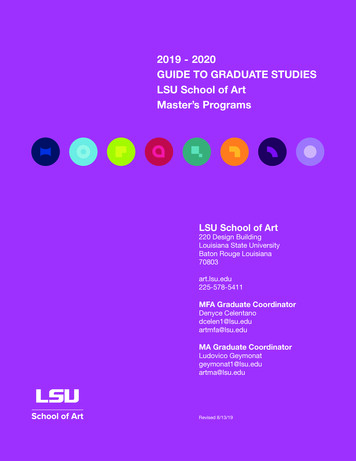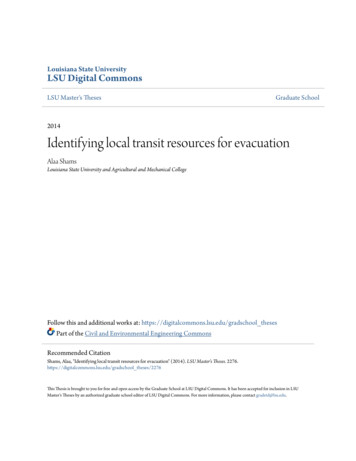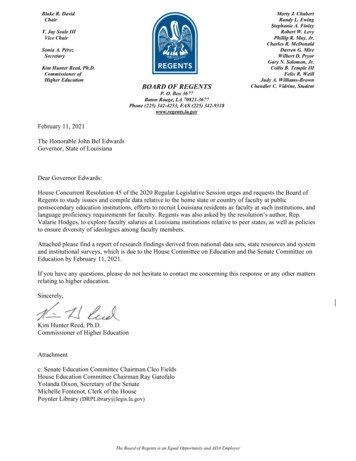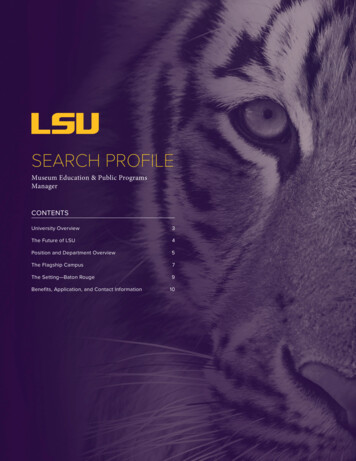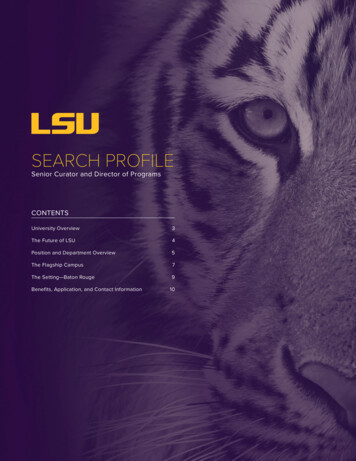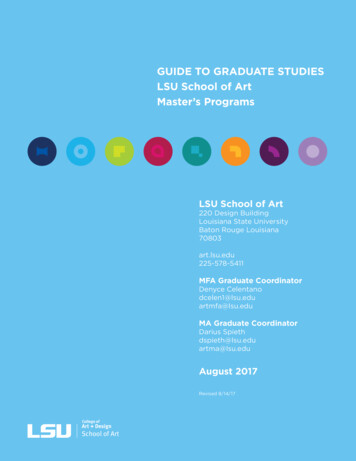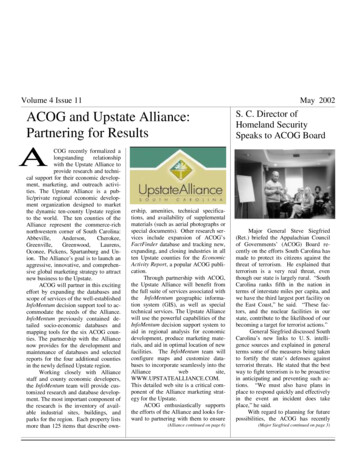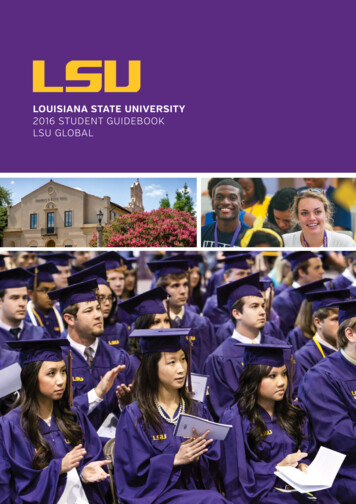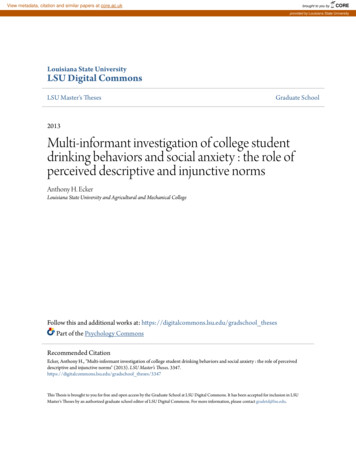
Transcription
View metadata, citation and similar papers at core.ac.ukbrought to you byCOREprovided by Louisiana State UniversityLouisiana State UniversityLSU Digital CommonsLSU Master's ThesesGraduate School2013Multi-informant investigation of college studentdrinking behaviors and social anxiety : the role ofperceived descriptive and injunctive normsAnthony H. EckerLouisiana State University and Agricultural and Mechanical CollegeFollow this and additional works at: https://digitalcommons.lsu.edu/gradschool thesesPart of the Psychology CommonsRecommended CitationEcker, Anthony H., "Multi-informant investigation of college student drinking behaviors and social anxiety : the role of perceiveddescriptive and injunctive norms" (2013). LSU Master's Theses. 3347.https://digitalcommons.lsu.edu/gradschool theses/3347This Thesis is brought to you for free and open access by the Graduate School at LSU Digital Commons. It has been accepted for inclusion in LSUMaster's Theses by an authorized graduate school editor of LSU Digital Commons. For more information, please contact gradetd@lsu.edu.
MULTI-INFORMANT INVESTIGATION OF COLLEGE STUDENT DRINKING BEHAVIORSAND SOCIAL ANXIETY: THE ROLE OF PERCEIVED DESCRIPTIVE AND INJUNCTIVENORMSA ThesisSubmitted to the Graduate Faculty of theLouisiana State University andAgricultural and Mechanical Collegein partial fulfillment of therequirements for the degree ofMaster of ArtsinThe Department of PsychologybyAnthony H. EckerB.S., Louisiana State University, 2009May 2013
Table of ContentsList of Tables . iiiAbstract. ivIntroduction . 1Variables related to social anxiety and alcohol use . 3Alcohol Effect Expectancies. 3Drinking Motives . 6Perceived Social Norms . 8Perceived Norms and Social Anxiety . 9The Current Study . 12Method .A Priori Power Analysis and Sample Size .Sample and Procedures .Measures .Participant measures .Friends’ measures .Data Analytic Strategy .14141416161920Results .Sample Characteristics and Correlation Between Study Variables .Do Students Misperceive Their Close Friend’s Drinking Behaviors? .Are Discrepancies Related to Drinking Behaviors and Social Anxiety? .Moderation Analyses .2222222424Discussion . 33Limitations and future directions . 36Conclusions . 37References . 38Appendix: IRB Approval Form . 45Vita . 50ii
List of Tables1. Correlations Among Study Variables . . 232. Hierarchical linear regression of potential moderators of social anxiety and alcohol usequantity relationship . .253. Hierarchical linear regression of potential moderators of social anxiety and alcohol usefrequency relationship . .274. Hierarchical linear regression of potential moderators of social anxiety and alcohol-relatedproblem severity relationship .295. Hierarchical logistic regression of potential moderators of social anxiety and binge drinkingrelationship 31iii
AbstractProblematic alcohol use in college is a major public health concern. Identification of variablesrelated to development of alcohol-related problems is an important research goal. Social anxietyand perceived social norms are two such variables. Social anxiety is associated with concurrentexperience of alcohol-related problems and development of future problems with alcohol.Perceived norms, especially norms related to perceived approval of risky alcohol use (i.e.,injunctive norms), are related to greater drinking problems among college students with highersocial anxiety. College students typically overestimate the amount that other students in generaluse alcohol, and the discrepancy between perceived and actual norms is related to problemswith alcohol. However, discrepancies between perceived and actual norms have not beenevaluated for proximal peer group alcohol quantity, frequency, alcohol-related problems, andapproval of risky drinking. The current study sought to identify if such discrepancies existed byasking 56 undergraduate online survey respondents to complete measures of alcohol use,alcohol-related problems, and perceived norms, and to refer one close friend who wouldcomplete a battery of self-report measures of their own alcohol use and actual norms. Resultssupported that students overestimated their friends’ injunctive norms and alcohol problems, butnot descriptive norms. Social anxiety was negatively correlated with drinking frequency and notsignificantly correlated with alcohol-related problems. Higher misperception of friends’ problemswas related to greater alcohol use quantity and alcohol-related problems. Higher injunctivenorms discrepancy was related to fewer drinking occasions. Results highlight the importance ofconsidering proximal peer groups when investigating the role of perceived norms and drinkingbehaviors.iv
IntroductionAlcohol use is very prevalent on college campuses, with over 63% of full-time collegestudents reporting past month alcohol use compared to 51.1% in the general U.S. population(Substance Abuse and Mental Health Services Administration, 2010). Many college drinkersalso report experiencing negative consequences related to drinking, such as engaging in riskybehaviors (e.g., driving under the influence of alcohol; Wechsler, Davenport, Dowdall, &Moeykens, 1994) and academic problems (e.g., lower GPA; Singleton, 2007). College studentsare also more likely than their non-college age peers to be diagnosed with an alcohol usedisorder (AUD; Slutske, 2005). Further, 63.6% of students reported binge drinking (i.e., fivedrinks within two hours for men, and four drinks within two hours for women) in the past year(Cranford, McCabe, & Boyd, 2006). This represents a much higher prevalence than thatobserved in the general population (15.5%; Chavez, Nelson, Naimi, & Brewer, 2011). Bingedrinking in college is associated with a higher likelihood of experiencing negative consequencesrelated to drinking such as getting in trouble with campus police and sustaining an injury(Wechsler et al., 1994). Risky drinking in college is not a time-limited phenomenon, but hasbeen linked with AUD even after students leave college (O'Neill, Parra, & Sher, 2001). Giventhat many college students engage in risky drinking and experience alcohol-related impairment,it is important to understand variables related to college student drinking.Social anxiety has been identified as one risk factor for alcohol-related problems (e.g.,Buckner & Schmidt, 2009; Buckner, Schmidt et al., 2008; Buckner & Turner, 2009; Crum &Pratt, 2001). Social anxiety disorder (SAD; also known as social phobia) is characterized bydistress and impairment related to fear of evaluation in social situations (American PsychiatricAssociation, 2000). Among individuals with a lifetime diagnosis of SAD, 27.3% also met criteriafor alcohol dependence and 20.9% met criteria for alcohol abuse (Schneier et al., 2010). Theserates are higher than those observed in the general population without SAD, in which 12.5%met criteria for alcohol dependence and 17.8% met criteria for alcohol abuse (Schneier et al.,1
2010). Comorbidity of these disorders has also been observed among college students, suchthat those with SAD were almost twice as likely to also have an AUD (Kushner & Sher, 1993).Studies using a retrospective design have shown that for many participants with co-occurringSAD and AUD, SAD tends to occur before the onset of AUD (Buckner, Timpano, Zvolensky,Sachs-Ericsson, & Schmidt, 2008; Randall, Thomas, & Thevos, 2001; Schneier, Johnson,Hornig, Liebowitz, & Weissman, 1992). SAD has also been related to a later onset of alcoholdependence even after controlling for presence of other co-occurring disorders (Buckner,Schmidt et al., 2008; Buckner, Timpano et al., 2008).Further, high levels of social anxiety in adolescence appear to be predictive of lateralcohol use problems. Prospectively, German adolescents aged 14-16 years who werediagnosed with SAD were more likely than those without SAD to develop heavy alcohol use (atleast 40g of ethanol per day for men, 20g for women) at 4-year follow-up (Zimmermann et al.,2003). SAD diagnosis in adolescence was a significant predictor of alcohol dependence onsetat age 30, even after controlling for other diagnoses (Buckner, Schmidt et al., 2008). Amongwomen aged 19-21, SAD predicted onset of AUD at three years follow-up (Buckner & Turner,2009).It appears that experiencing some symptoms of social anxiety without meeting fullcriteria for the disorder is a risk factor for later development of alcohol-related problems.Individuals with subclinical levels of social anxiety were more likely than those without significantlevels to develop heavy drinking patterns (i.e., 5 or more drinks on one occasion) and AUD at amedian 12.6 year follow-up (Crum & Pratt, 2001). Among older adolescents, higher selfreported social anxiety was related to subsequent onset of AUD (Buckner & Schmidt, 2009).Drinkers who reported alcohol-related impairment endorsed greater fear of negative evaluationthan drinkers who did not report problems related to their alcohol use (B. A. Lewis & O'Neill,2000). Further, higher scores of self-reported social anxiety were positively related to both morealcohol dependence symptoms and more alcohol-related problems (Gilles, Turk, & Fresco,2
2006). Social anxiety has also been related to alcohol-related impairment among collegestudents (Buckner, Eggleston, & Schmidt, 2006; Buckner & Heimberg, 2010; Stewart, Morris,Mellings, & Komar, 2006). Among college students mandated by their university and studentswho volunteered to receive a brief motivational intervention for heavy drinking, those with higherlevels of social anxiety reported greater alcohol use quantity than those without elevated socialanxiety allocated to an assessment-only control group (Terlecki, Buckner, Larimer, & Copeland,2011). Given these findings, adolescence and young adulthood appear to be critical timeperiods for identifying factors related to alcohol-related impairment among those with elevatedsocial anxiety.Despite the observed associations between social anxiety and alcohol-related problems,the relationship between social anxiety and drinking quantity and frequency among collegestudents is less clear. Social anxiety has been found to be unrelated to drinking quantity andfrequency in most studies (Bruch, Heimberg, Harvey, & McCann, 1992; Bruch, Rivet, Heimberg,& Levin, 1997; Buckner, Ecker, & Proctor, 2011; Buckner, Mallott, Schmidt, & Taylor, 2006;Ham & Hope, 2006). Yet some find social anxiety to be inversely related to alcohol use quantity(Ham & Hope, 2005) and frequency (Eggleston, Woolaway-Bickel, & Schmidt, 2004). Somework has also found that higher social anxiety is related to greater alcohol use quantity andfrequency (Neighbors et al., 2007). Given these mixed findings, it may be that other variablesmoderate the relationship between social anxiety and alcohol use quantity and frequency.Variables related to social anxiety and alcohol useAlcohol Effect Expectancies. Alcohol outcome effect expectancies (AOEs) havereceived the most empirical attention in efforts to understand the relationship between socialanxiety and drinking behaviors. AOE refers to the effect that an individual expects to experienceas a result of using alcohol (Brown, Goldman, Inn, & Anderson, 1980). AOE can be classifiedinto positive expectancies (e.g., alcohol will help one relax or be more social) or negativeexpectancies (e.g., alcohol will cause unpleasant physical symptoms). Early work in AOE found3
that both the specific type of AOE and degree to which an individual believes an AOE arerelated to one’s pattern of alcohol consumption (Brown et al., 1980; Johnson, 1994).In support of the contention that AOE plays a role in the relationship between socialanxiety and drinking, social anxiety has been found to be positively related to tension reductionand social assertiveness AOE (O'Hare, 1990). Drinkers who reported alcohol-relatedimpairment reported higher levels of social anxiety and higher positive AOE than drinkers notexperiencing alcohol-related impairment (B. A. Lewis & O'Neill, 2000). Among college studentswith clinical levels of social anxiety, students with high social facilitation AOE and low selfefficacy for refusing to drink heavily in social situations reported higher drinking quantity andfrequency than those with lower social facilitation AOE and higher self-efficacy (Carrigan, Ham,Thomas, & Randall, 2008). College students with high social anxiety, high social facilitationAOE, and low self-efficacy to refuse drinks reported higher drinking quantity and frequency(assessed using a combined measure of quantity and frequency) than students with low socialanxiety and other variations of social facilitation AOE and self-efficacy (Gilles et al., 2006).Among college students with clinical levels of social anxiety, tension-reduction AOE moderatedthe relationship between social anxiety and drinking games (a behavior related to alcoholrelated problems; Borsari, Murphy, & Barnett, 2007), such that those with higher social anxietywho endorsed tension reduction expectancies engaged in drinking games more frequently thatthose with higher social anxiety who did not endorse tension-reduction expectancies (Ham,Zamboanga, Olthuis, Casner, & Bui, 2010). AOE (positive and negative) mediated therelationship between social anxiety and alcohol-related problems (Ham & Hope, 2005).However this finding was no longer significant after controlling for negative affect.Further, positive AOE in a party or gathering context moderated the relationship betweensocial anxiety and hazardous drinking (defined as a combined measure of alcohol use quantityand frequency, AUD symptoms, and alcohol-related problems) such that among thoseendorsing high positive AOE, social anxiety was related to hazardous drinking (Ham,4
Zamboanga, & Bacon, 2011). Among those endorsing high negative AOE, social anxiety wasnegatively related to hazardous drinking, but the relationship was positive when low negativeAOE were endorsed.Although there is some evidence that AOE is related to risky drinking among people withsocial anxiety, other studies suggest that the nature of the relationships among these variablesdoes not support this hypothesis. For example, social AOE moderated the relationship betweensocial anxiety and alcohol use frequency (Tran, Haaga, & Chambless, 1997). However, thenature of the moderation did not support the idea that socially anxious students with high socialanxiety and high social AOE would drink more often than those with low social anxiety. Rather,the pattern of findings suggests that those with higher social anxiety and high tension-reductionexpectancies may actually drink less than those with low social anxiety. Further, students whoendorsed high social AOE did not differ based on social anxiety levels, and those students withlow social AOE and high social anxiety drank less often than those with low social anxiety.Moderation was not observed with tension-reduction AOE in that study. AOE failed to mediatethe relationship between social anxiety and alcohol use (Bruch et al., 1992). Interestingly, in thatsample, positive sociability AOE served as a suppressor variable in the relationship betweenshyness and drinking patterns. That is, when individuals endorsed higher levels of sociabilityAOE, the inverse relationship between shyness and drinking quantity/frequency (combinedmeasure) was weaker compared to the relationship observed when low sociability expectancieswere endorsed. A similar suppression effect was replicated by Bruch et al. (1997). AOE(positive and negative) also did not mediate the relationship between social anxiety and alcoholconsumption (i.e., combined measure of quantity, frequency, and binge drinking) among collegestudents (Eggleston et al., 2004). Similarly, general positive and negative AOE did not moderatethe relationship between social anxiety and alcohol-related problems (Ham & Hope, 2006).Social AOE also did not moderate the relationship between social anxiety and alcohol-relatedproblems (Ham, Zamboanga, Bacon, & Garcia, 2009).5
Further complicating the study of AOE, recent work suggests that researcher-definedAOE (i.e., positive and negative) may not map on to what college students define as positiveand negative consequences of drinking (Patrick & Maggs, 2011). That is, although researchersmay believe they are measuring positive and negative AOE, college students may have moreheterogeneous beliefs regarding how they perceive AOE. Given that there is little agreementwithin the literature regarding AOE’s role as a mediator or moderator of the relationship betweensocial anxiety and alcohol use behavior, it may be that variables other than AOE are involved inthe relationship between social anxiety and drinking.Drinking Motives. Drinking motives have also been identified as variables that may playa role in drinking behaviors among socially anxious individuals. Drinking motives refer to thereasons that an individual chooses to use alcohol, which may be more relevant to an individual’sdecision to use alcohol than AOE. In a model tested by Cooper et al. (1995), AOE shape anindividual’s reasons for drinking, and these reasons for drinking are in turn related to alcoholconsumption and alcohol-related problems. For example, if an individual expects that alcoholwill help to relieve stress or anxiety (i.e., tension-reduction AOE) then it is likely that theindividual drinks to relieve stress or anxiety (i.e., coping motives). Higher tension-reduction AOEwere related to higher endorsement of coping motives, which were in turn were related togreater alcohol consumption and alcohol-related problems (Cooper et al., 1995).Emerging literature has investigated the role of drinking motives in the relationshipbetween social anxiety and alcohol use among college students. Coping motives and conformitymotives (i.e., drinking to conform to social pressure) mediated the relationship between socialanxiety (assessed by a combined score on measures of social interaction anxiety, social fears,and social avoidance) and alcohol-related problems (M. A. Lewis et al., 2008). Coping andconformity motives also mediated the relationship between fear of negative evaluation anddrinking-related problems (Stewart et al., 2006). Given these findings, students who drink tocope with social anxiety and drink to conform to others may be at particular risk for alcohol-6
related problems. However, like AOE, coping motives’ role in social anxiety and drinking maynot be that simple. Buckner et al. (2006) found that enhancement motives (e.g., enhancing apleasant experience), but not coping motives, mediated the relationship between socialinteraction anxiety and alcohol-related problems. Further, Ham et al. (2007) did not observesignificant relationships between social anxiety (interaction and performance anxiety) and anydrinking motives. Rather, only among those with high social anxiety, coping motives wererelated to more drinking-related problems, although this relationship was not observed aftercontrolling for alcohol use quantity and frequency. Yet in another study social anxiety wasrelated to coping, conformity, enhancement, and social drinking motives (Ham et al., 2009).However, coping motives (but not conformity motives) mediated the relationship between socialanxiety and hazardous drinking. In a related population (adolescents aged 12-17), social anxietywas related to coping motives for alcohol use, but no other motives (Blumenthal, Leen-Feldner,Frala, Badour, & Ham, 2010). However, coping motives did not moderate the relationshipbetween social anxiety and alcohol use frequency. Taken together, the extant literaturesuggests that although coping motives (and perhaps other motives) may play an important rolein the relationship between social anxiety and alcohol use problems, it may be that othervariables are involved in the relationship.In sum, it appears that although AOE and drinking motives may be related to riskydrinking behaviors among some with elevated social anxiety, these constructs do not sufficientlyaccount for differences observed in findings regarding the relationship between social anxietyand alcohol use. It may be that lack of attention to social norms’ role in these constructscontributes to the inconsistencies in findings. Further, socially anxious students’ perceptions ofothers’ drinking norms may shape their AOE and motives for drinking, as they may be drinkingto cope, conform, or for social facilitation only if they believe that others approve of drinking.Therefore, it seems that perceived social norms are important to the relationship between socialanxiety and drinking behaviors.7
Perceived Social NormsPerceived social norms play a role in college student problematic drinking (for reviewsee Borsari & Carey, 2001). Those with elevated social anxiety may use alcohol to cope withtheir anxiety because they believe it is socially acceptable to do so based on their perceptionthat others drink much alcohol and approve of drinking. That is, they may be using alcoholbecause they believe others will not judge them for using alcohol (Buckner, Heimberg, Ecker, &Vinci, 2012). The two types of social norms that have received the most empirical attention areperceived descriptive norms and perceived injunctive norms.Perceived descriptive norms refer to one’s perception of how much other students drink.College students typically overestimate the amount that other students drink (Borsari & Carey,2003; M. A. Lewis & Neighbors, 2004; Martens, Dams-O'Connor, Duffy-Paiement, & Gibson,2006) and the amount of alcohol-related impairment experienced by other students (Baer,Stacy, & Larimer, 1991). Higher perceived descriptive norms are related to greater alcohol usequantity and frequency (Clapp & McDonnell, 2000; Neighbors, Dillard, Lewis, Bergstrom, & Neil,2006), drinking five or more drinks on one occasion (Clapp & McDonnell, 2000), and drinkingrelated problems (Ham & Hope, 2005).Perceived injunctive norms refer to one’s perception of the extent to which othersapprove of risky drinking behaviors. Students with higher perceived injunctive norms were morelikely to report greater drinking quantity and frequency (Wood, Nagoshi, & Dennis, 1992).Further, it may be that the reference group of perceived norms plays an important role, asperceived injunctive norms were negatively correlated with alcohol use quantity when thereference group was students in general (Neighbors et al., 2008). However, when close friendswere used as the reference group, higher perceived injunctive norms were related to greaterdrinking quantity. Thus, beliefs about proximal groups may serve as a more salient influence ondrinking behaviors.8
Despite theoretical reason to posit that perceived injunctive norms are associated withdrinking-related problems, the literature has been mixed. Higher perceived injunctive normshave been shown to be both related (Buckner et al., 2011) and unrelated (Wood et al., 1992) todrinking-related problems. However these two studies may represent findings related to differentconstructs, as Buckner et al. defined injunctive norms as approval of risky drinking (e.g.,drinking enough to pass out, driving while intoxicated), and Wood et al. defined injunctive normsas approval of drinking quantity and frequency. Taken together, these data suggest thatinjunctive norms assessed as perceived approval of risky drinking (rather than injunctive normsregarding quantity and frequency) are more relevant to alcohol-related problems.Perceived Norms and Social Anxiety. Emerging data suggest that perceived socialnorms are related to drinking behaviors among those with social anxiety, although the extantfindings are mixed as to the nature of norms in this relationship. In support of the role ofdescriptive norms in drinking behaviors among those with social anxiety, social anxietymoderated the relation between descriptive norms and drinking quantity such that students withhigher levels of social anxiety who also endorsed high descriptive norms reported greaterdrinking quantity than those with lower social anxiety and high descriptive norms (Neighbors etal., 2007). Descriptive norms also mediated the relationship between social anxiety and alcoholuse (quantity and frequency combined; Ham & Hope, 2006). However, counter to the notion thatdescriptive norms may be related to risky drinking among those with social anxiety, one studyfound that descriptive norms moderated the relationship between social anxiety and drinkingquantity such that among college students with low descriptive norms, students with high socialanxiety reported greater drinking quantity than those with low social anxiety (Buckner et al.,2011). Further, among young adolescents with high levels of social anxiety, high descriptivenorms endorsement and low need for peer affiliation need were related to less drinking thanthose with lower levels of social anxiety (Anderson, Tomlinson, Robinson, & Brown, 2011).Descriptive norms may not influence the relationship between social anxiety and alcohol-related9
problems, as descriptive norms have not been observed to moderate (Buckner et al., 2011) ormediate (Ham & Hope, 2005, 2006) this relationship.The literature on injunctive norms’ relation to social anxiety and alcohol use is similarlymixed. In support of the notion that injunctive norms may play a role in the relation betweensocial anxiety and alcohol use, those with higher injunctive norms and elevated social anxietyreported having more drinks per month than those with elevated social anxiety who endorsedlower injunctive norms (LaBrie, Hummer, & Neighbors, 2008). Yet counter to the view thatinjunctive norms are related to risky drinking among socially anxious students, Buckner et al.(2011) found that injunctive norms moderated the relationship between social anxiety anddrinking frequency such that those with high social anxiety and high perceived injunctive normsdrank less frequently than those with low social anxiety and high injunctive norms. However,consistent with the evidence that injunctive norms related to risky drinking may be more relevantto problems than drinking quantity or frequency, injunctive norms moderated the relationbetween social anxiety and drinking problems such that those who endorsed clinical levels ofsocial anxiety and high injunctive norms reported more severe alcohol-related problems thanthose with lower social anxiety and high injunctive norms, as well as those with both low socialanxiety and low injunctive norms (Buckner et al., 2011).It may be that the inconsistent findings regarding perceived norms’ moderational role(Bruch et al., 1992; Bruch et al., 1997; Buckner et al., 2011; Ham & Hope, 2005, 2006;Neighbors et al., 2007) are due to a lack of attention to proximal peer influence. This may bedue to the methods used to assess perceived norms. Neighbors et al. and Buckner et al. usedtypical students at the university as the reference group for perceived norms, but it has beenshown that more proximal reference groups (e.g., close friends) relate to perceived normsdifferentially (Neighbors et al., 2008). Specifically, high endorsement of perceived injunctivenorms of friends was related to heavy alcohol use, but high endorsement of perceived injunctivenorms of typical students was not related to alcohol use. Ham & Hope (2005, 2006) used a10
combined measure of typical student and friend norms, which may not have been able to tapinto differences in reference groups. Bruch et al. (19
It has been accepted for inclusion in LSU Master's Theses by an authorized graduate school editor of LSU Digital Commons. For more information, please contactgradetd@lsu.edu. Recommended Citation Ecker, Anthony H., "Multi-informant investigation of college student drinking behaviors and social anxiety : the role of perceived
